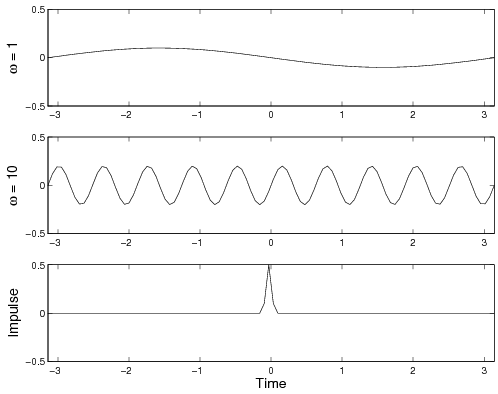Exercise: Vehicle suspension system modeling and input response
(Contributed by Demetri Spanos and Haomiao Huang, 3 Oct 04)
In this problem we will explore a simple example of a suspension system for a vehicle. In general, mechanical systems respond differently to different inputs. One categorization of inputs is in terms of "frequency content". We will analytically study a simple mechanical system to understand its response to the three kinds of inputs shown in the figure below:

One aspect of a car's dynamics is the interaction of the car chassis with the
suspension. As a crude model, we will treat the chassis as a lumped mass
 , and the suspension as a linear stiffness with constant
, and the suspension as a linear stiffness with constant
 . We will also assume that the suspension includes a
viscous damper (shock-absorber) with damping coefficient
. We will also assume that the suspension includes a
viscous damper (shock-absorber) with damping coefficient
 . Newtonian mechanics gives the following differential
equation for the body dynamics:
. Newtonian mechanics gives the following differential
equation for the body dynamics:

Here,  is the input force from the ground. The three inputs
shown represent relatively smooth road, very bumpy road, and a single
isolated bump.
is the input force from the ground. The three inputs
shown represent relatively smooth road, very bumpy road, and a single
isolated bump.
Setting
 , analytically solve the
differential equation for the steady-state solution, in terms of
the system parameters
, analytically solve the
differential equation for the steady-state solution, in terms of
the system parameters  , and the driving
frequency
, and the driving
frequency  . Assume
. Assume  so that the
system is underdamped (typical of this kind of mechanical system).
so that the
system is underdamped (typical of this kind of mechanical system).
Sketch the amplitude of the steady-state response as function of the driving frequency
 . Identify the maximum
of this plot in terms of the model parameters.
. Identify the maximum
of this plot in terms of the model parameters.
The parameters that enter a model influence its behavior. Consider the limiting cases
 and
and
 . What does your amplitude plot
tell you about the response to these two different frequencies?
What about inputs near this frequency?
. What does your amplitude plot
tell you about the response to these two different frequencies?
What about inputs near this frequency?
The third input shown is called an "impulse", and is usually modeled as discontinuously altering the velocity of the system. This happens, for example, when driving over a sharp step in elevation. Setting
 , solve the differential equation
with initial conditions
, solve the differential equation
with initial conditions  ,
,  , as a
function of the system parameters. Again assume the system is
underdamped.
, as a
function of the system parameters. Again assume the system is
underdamped.
Do you see any relationship between the oscillation frequency of this solution and the amplitude plot for the steady-state solution?
What do your answers above tell you about the role of the car's mass in reducing the effect of impulsive disturbances?